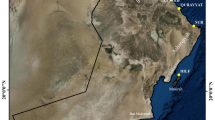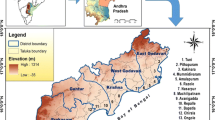Abstract
With continued climate change, coastal areas are subjected to undesirable situations in the form of sea-level rise and its adverse outcomes like storm surge, flooding and erosion. Being a unique geographic location, low topography, relatively higher population density as well as overwhelming dependence on natural resources, Bangladesh is one of the vulnerable countries exposed to the impacts of global warming and climate change. Bhola in southern Bangladesh represents the world’s most dynamic estuary is potentially vulnerable to accelerated sea level rise and associated calamities. The present study aims to develop a coastal vulnerability index (CVI) using eight parameters namely (a) geomorphology, (b) slope, (c) relative sea level change rate, (d) mean tide range (e) shoreline erosion and accretion, (f) population (g) bathymetry and (h) coastal flooding which were addressed as the relative risk variable for the study area using geospatial techniques i.e., Remote Sensing and GIS. The aforementioned parameters were ranked on the basis of their potential contribution to physical changes on the coast, as sea-level rises, and the final calculation was done over 263.87 km shoreline by the square root of the mean values of the ranked variables. According to the vulnerability index, about 22 % corresponding to 57.23 km of the entire coast is under very high-risk and another 29 % representing 75.26 km is under high-risk. Again, 25 % encompassing 67.69 km shoreline is at moderate risk and 24 %, that is 63.69 km shoreline is found to be at low risk. The most vulnerable coastal regions are found mainly along the western coast of Char Fasson and northern and southwestern coast of Bhola Sadar of Bhola Island.




Similar content being viewed by others
References
Abuodha, P., & Woodroffe, C. D. (2010). Assessing vulnerability to sea-level rise using a coastal sensitivity index: a case study from southeast Australia. Journal Coast Conservation, 14, 189–205.
Allen, J. C., & Kumar, P. D. (2006). Climate controls on US west coast erosion processes. Journal of Coastal Research, 22, 511–529. doi:10.2112/03-0108.1.
Arun, K. A., & Pravin, D. K. (2012). Coastal vulnerability assessment for Chennai, east coast of India using geospatial techniques. Natural Hazards. doi:10.1007/s11069-012-0276-4.
BBS (2011). Population and housing census 2011 Bangladesh Bureau of Statistics (BBS), Ministry of Planning, Government of the People’s Republic of Bangladesh, Dhaka Available via http://www.bbs.gov.bd/PageWebMenuContent.aspx?MenuKey=423 accessed on 29 November 2013.
Choudhury, A. M., Haque, M. A., & Quadir, D. A. (1997). Consequences of global warming and sea level rise in Bangladesh. Mar Geodes, 20, 13–31.
Cruz, R. V., Harasawa, H., Lal, M., Wu, S., Anokhin, Y., Punsalmaa, B., Honda, Y., Jafari, M., Li, C., Ninh, N. H. (2007). Asia. In: Parry ML, Canziani OF, Palutikof JP, von der Linden PJ, Hanson CE (eds) Climate change 2007: impacts, adaptation and vulnerability. Contribution of working group II to the Fourth Assessment Report of the Intergovernmental Panel on Climate Change. Cambridge University Press, Cambridge, pp 469–506
Devoy, R. J. N. (1992). Questions of coastal protection and the human response to sea-level rise in Ireland and Britain. Irish Geography, 25(1), 1–22.
Diez, P. G., Perillo, G. M. E., Piccolo, M. C. (2007). Vulnerability to sea-level rise on the coast of Buenos Aires province. Journal of Coastal Research 23, 119– 126. doi:10.2112/04-0205.1
Dilley, R. S., & Rasid, H. (1990). Human response to coastal erosion: Thunder bay, Lake superior. Journal of Coastal Research, 6(4), 779–788.
Doukakis, E. (2005). Coastal vulnerability and risk parameters. Eur Water, 11(12), 3–7.
Gornitz, V. (1991). Global coastal hazards from future sea level rise. Palaeogeography Palaeoclimatology Palaeoecology, 89, 379–398. doi:10.1016/ 0031-0182(91)90173-O.
Hansen, J., Ruedy, R., Sato, M., et al. (2001). A closer look at United States and global surface temperature change. Journal of Geophysical Research, 106, 23947–23963. doi:10.1029/2001JD000354.
Hansen, J., Sato, M., Ruedy, R., Ken, L., David, W. L., Martin, M-E. (2006). Global temperature change. Proceedings of the National Academy of Sciences of the United States of America, 103, 14288–14293. doi:10.1073/ pnas.0606291103.
IPCC Summary for Policymakers. In: Soloman, S. D., Manning, Q.M., Chen. Z. & Miller, H. L. (ed) Climate Change 2007: the PhysicalScience Basis. Contribution of Working Group I to the Fourth Assessment Report of the Intergovernmental Panel on Climate Change. Cambridge University Press, Cambridge pp 1–18.
Islam, M. A., Majlis, A. B. K., & Rashid, M. B. (2011). Changing face of Bangladesh coast. The Journal of NOAMI, 28(1), 1–13.
Klein, R.J.T., Reese, S., & Sterr, H. (2000). Climate change and coastal zones: an overview of the state-of-the-art on regional and local vulnerability. In: Giupponi C, Shechther M (eds) Climate change in the mediterranean: socio-economic perspective of impacts, vulnerability and adaptation. Edward Elgar Publishing, Camberley, pp 245–278.
Pendleton, E.A., Thieler, E. R. & Williams, S. J. (2004). Coastal vulnerability assessment of Cape Hettaras National Seashore (CAHA) to sea level rise. USGS Open File Report 2004–1064.
McLaughlin S, McKenna J, Cooper JAG (2002) Socio-economic data in coastal vulnerability indices: constraints and opportunities. Journal of Coastal Research 36, 487–497.
Nageswara Rao, K., Subraelu, P., Venkateswara Rao, T., Hema Malini, B., Ratheesh, R., Bhattacharya, S., Rajawat, AS., & Ajai. (2008). Sea-level rise and coastal vulnerability: an assessment of Andhra Pradesh coast India through remote sensing and GIS. Journal of Coastal Conservation, 12, 195–207. doi:10.1007/s11852-009-0042-2.
Rashid, M. B., & Mahmood, A. (2011). Longshore currents and its effect on Kuakata beach, Bangladesh, national seminar on Bangladesh coast: Geology hazards and resources, 29–30 July, 2011. People’s Republic of Bangladesh: Organized by Geological Survey of Bangladesh.
Rivas, V., & Cendrero, A. (1994). Human influence in a low-hazard coastal area: An approach to risk assessment and proposal of mitigation strategies. In C. W. Finkl (Ed.), Coastal hazards: Perception, susceptibility and M i t i g a t i o n (pp. 289–298). Fort Lauderdale: The Coastal Education and Research Foundation.
Rosenzweig, C., Koroly, D., Vicarelli, M., Peter, N., Qigang, W., Gino, C. et al. (2008). Attributing physical and biological impacts to anthropogenic climate change. Nature, 453, 353–357. doi:10.1038/nature06937.
Ryan, W. B. F., Carbotte, S. M., Coplan, J. O., O'Hara, S., Melkunian, A., Arko, R. et al. (2009). Global multi-resolution topography synthesis. Geochemistry, Geophysics, Geosystems, 10, Q03014. doi:10.1029/2008GC002332.
Sarwar, G. M. (2013). Sea-Level Rise Along the Coast of Bangladesh. R. Shaw et al. (eds.), Disaster Risk Reduction Approaches in Bangladesh, Disaster Risk Reduction, doi:10.1007/978-4-431-54252-0_10, © Springer Japan 2013.
Singh, O. P. (2002). Spatial variation of sea level trend along the Bangladesh coast. Mar Geodes, 25, 205–212.
Thieler, E. R. & Hammar-Klose, E. S. (1999). National assessment of coastal vulnerability to future sea-sevel rise: Preliminary results for the U.S. Atlantic Coast: U.S. Geological Survey. Open-File Report 99–593 URL.
Trenberth, K. E., Jones, P. D., Ambenje, P., Bojariu R., Easterling D., Klein T., Parker D., Renwick J., Rusticucci M., Soden B., & Zhai P. (2007). Climate change 2007. In S. Solomon, D. Qin, M. Manning, et al. (Eds.), The physical science basis (pp. 235–336). Cambridge: Contribution of WG 1 to the Fourth Assessment Report of the Intergovernmental Panel on Climate Change Cambridge University Press.
Wood, R. (2008). Natural ups and downs. Nature, 453, 43–45. doi:10.1038/453043a.
Yin, J., Yin, Z., Wang, J., & Xu, S. (2012). National assessment of coastal vulnerability to sea-level rise for the Chinese coast. Journal of Coastal Conservation, 16, 123–133. doi:10.1007/s11852-012-0180-9.
Author information
Authors and Affiliations
Corresponding author
About this article
Cite this article
Islam, M., Hossain, M. & Murshed, S. Assessment of Coastal Vulnerability Due to Sea Level Change at Bhola Island, Bangladesh: Using Geospatial Techniques. J Indian Soc Remote Sens 43, 625–637 (2015). https://doi.org/10.1007/s12524-014-0426-0
Received:
Accepted:
Published:
Issue Date:
DOI: https://doi.org/10.1007/s12524-014-0426-0




